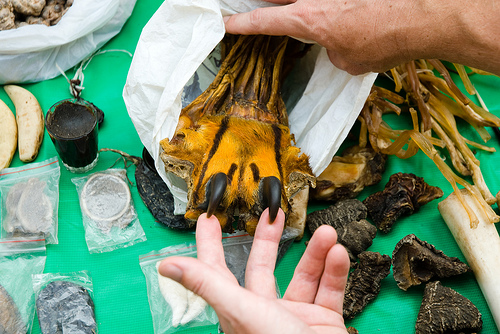If there is a face of terror in the animal world, it has to be that of Sansar Chand, a wildlife poacher whose lists of lifetime accomplishments include killing 250 tigers, 2,000 leopards, 5,000 otters, 20,000 wild cats, 20,000 wild foxes and hundreds of other unaccounted wildlife. Dubbed Verappan of the North, the 55 year old has spent 40 years of his life killing and selling animals. Often using legal loopholes to wriggle out of jail time, this notorious poacher was finally arrested in 2005, many hoping this to be the end of his past bloody acts. But on Tuesday this week, the man seems to have once again found a loose end in the legal leash, rendering it impossible once again to punish him suitably for his heinous crimes.

A Delhi court on Tuesday refused to slap a stringent anti-organized crime law against Sansar Chand, which would have ensured severe punishment for the poacher. Chand’s lawyers argued against being charged under the Maharashtra Control of Organised Crime Act (MCOCA) on technical grounds as it was filed as a supplementary charge.
Arrested by the Delhi police in a dramatic, top secret swoop codenamed ‘Operation Murari Lal’, in 2005, Sansar Chand was accused in at least 50 cases of killing and cruelty to animals. But thanks to shoddy investigations and the man’s clear ability to use the legalities in building his case, the efforts of the police seem to be in vein. Chand has already cleared himself in few other cases registered against him as per the Indian Wildlife Act. It may be matter of few weeks when the beast is out of jail free to prey on Indian wildlife once again.
Life of Crime
In 1974 when Sansar Chand was just 16 years old, his grandfather Pannalal introduced him to the family business – killing wildlife for commercial uses. At that time, the wildlife department raided their home and recovered skin of a tiger, 567 lizards, 85 otters and a red panda. Sansar Chand was convicted but released under probation since he was a juvenile. Wildlife crime was still not regarded as a severe offence during those years, and this first lenient punishment became the base on which Chand build his empire and villainous repute of becoming India’s ace poacher ravaging the forest in the next four decades.

Chand’s empire today is literally built over animal bones. As per official records the poacher has 45 properties, some of them covering an entire lane in Delhi’s Sadar Bazar. Even from conservative estimates, this may come to around 100 crore in investments alone. Sealing of these properties is not within the purview of the Indian Wildlife (Prevention) Act, 1972, under which most of the cases are being tried. The MCOC could have been helpful, but now even this glimmer of hope is gone.
No surprise then that his entire family, including wife, son, daughter, brother and several other family members are proudly part of and sustaining the family business.
Former CBI ace investigator BK Sharma said, “We kept track of Sansar Chand when he was in Jaipur jail… His wife Rani, son Akash and even his daughter and brother Narain used to meet him regularly. We noted down the timings and number of meetings that had taken place in the Jaipur jail.”
The police are sure Chand continues to operate uninterrupted even from within the prison walls.
Close but Never Enough
Chand and the law enforcement officers always seemed to have played the cat and mouse chasing game where the villain invariably has a trick up his sleeve making it easy for him to slip away.
Note some of the past cases,
- Chand and his mother Manuka Devi were arrested on 23 February 1990 after a raid at the ancestral home that yielded a tiger skin, 17 leopard skins, 74 other skins and 30 kg of tiger bones. He submitted a ration card as proof that he lived at another address.
- In 1993 the police caught two men with a large consignment of six tiger skins, 26 tiger cub skins and 43 leopard skins that they were delivering to Chand in New Delhi. The case wound its way through the court for 17 long years, but Chand was found not guilty as the police had failed to give evidence that it was he indeed who was receiving the consignment.
- On January 6, 2003 the first clear link between him and wildlife crime was established when the poacher Sansar Chand caught redhanded in a train compartment with two leopard skins. he skipped bail and could be apprehended by Delhi Police only after a few months, on 30 June 2005. Sadly, even then no one appeared from the Rajasthan government to stand by as a witness to his crime.
Although Chand is still in jail for the other crimes, considering his cunning ways of spotting the loop holes in the system, the master poacher may soon be walking free again.
It is also not just the lacuna in the legal system that is helping poachers like Chand to escape severe punishments.
Tehelka reports, in 2007, the environment ministry created the Wildlife Crime Control Bureau on the lines of the Narcotics Control Bureau, but it is not an enforcement agency like the latter. It can search, seize and summon people, but lacks a forensic lab or research wing.
A member of its advisory group, Supreme Court lawyer Sanjay Upadhyay, has an explanation.
“Wildlife inspectors and state police are not even capable of differentiating between cow and tiger bones,” he says. “They don’t even know that the moth is a Scheduled animal!”
In Chand’s case too, in the three cases where he was caught with animal parts, the police were unable to submit a single forensic report proving that the bones he was carrying were that of a tiger.
Changing with the times
Sansar Chand sold his tiger skins for Rs. 90,000 in 2005. Leopard skins were sold at around Rs. 17,000 to Rs. 18,000. Today, the illegal wildlife market is selling the same tiger skin for not less that Rs. 3-3.5 lakhs. Tiger bones, claws, bile and other body parts have other rates all equivalent to a pot of gold. Poaching has become an organised crime, one that is now recognised second only to acts of terrorism. Sansar Chand may be the most recognised face in this world, but today, there are many more already in his shoes and some ready to become bigger and better with militant groups backing them up with financial muscle and latest arms and ammunitions.

Under such circumstances can the 1972 era approach of fighting crime against wildlife still be called relevant? The efforts to increase the number of tigers in the forests then, will only be to ease the number of targets for poachers and not justly for the species conservation. Sansar Chand and his brothers in arm need to be treated as criminals who deserve the most stringent punishment possible. Because if this unrepentant poacher has his way, he will skin every tigers that exists in India and the world.
More Related Stories,
Soon an ID Card for Every Tiger in India
Image via cc/Flickr by Gopal Venkatesan and Dan Bennett









4 thoughts on “Will a Poacher have the Last Laugh?”